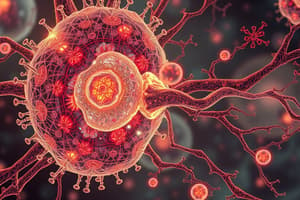Podcast
Questions and Answers
What are the types of molecules that can act as ligands?
What are the types of molecules that can act as ligands?
- Antibodies, cytokines, chemokines, and adhesion molecules
- Proteins, carbohydrates, nucleic acids, and lipids
- Hormones, enzymes, neurotransmitters, and lipids
- Growth factors, inhibitors, extracellular matrix components, and cell adhesion molecules (correct)
What are the three domains of receptors on cell surfaces?
What are the three domains of receptors on cell surfaces?
- Extracellular, intracellular, and transcytoplasmic
- Cytosolic, endosomal, and nuclear
- Extracellular ligand-binding, transmembrane, and intracellular (correct)
- Membrane-bound, soluble, and secreted
How do normal cells respond to ligand binding?
How do normal cells respond to ligand binding?
- By inducing cell death
- By decreasing cell division
- By activating a cascade of signals (correct)
- By inhibiting protein synthesis
Flashcards are hidden until you start studying
Study Notes
- Ligands deliver signals for normal cell growth.
- Ligands can be growth factors, inhibitors, extracellular matrix components, or cell adhesion molecules.
- Receptors on cell surfaces transmit signals into the cell.
- Receptors often consist of three domains: extracellular ligand-binding, transmembrane, and intracellular.
- Tyrosine kinase is a receptor activated by ligand binding.
- Tyrosine kinase activates other proteins by phosphorylation.
- Normal cells respond to ligand binding by activating a cascade of signals.
- The nucleus is signaled to promote cell growth and division or stop growth.
- Cellular restraints on gene expression limit receptor production.
- Protein translation is also a factor in receptor production.
Studying That Suits You
Use AI to generate personalized quizzes and flashcards to suit your learning preferences.




